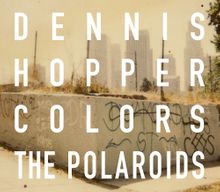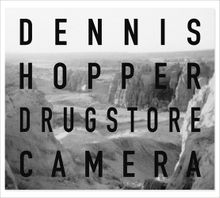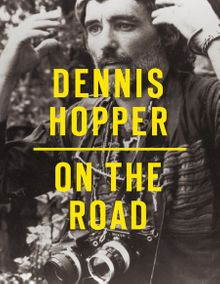PHOTOGRAPHY MONOGRAPHS
|
|
in stock $49.95 Free Shipping UPS GROUND IN THE CONTINENTAL U.S. |
 Dennis Hopper: Colors, The Polaroids
Dennis Hopper: Colors, The Polaroids
Published by Damiani.
Text by Aaron Rose.
After losing himself in Taos, New Mexico, for 15 years, Dennis Hopper (1936–2010) returned to Los Angeles in the mid-’80s. In 1987, on the verge of directing Colors, Hopper made use of a Polaroid camera to document gang graffiti in Los Angeles. He was particularly drawn to the abstract shapes of overlapping paint that appeared when graffiti had been covered up or written over, reminding him, he said, “that art is everywhere in every corner that you choose to frame and not just ignore and walk by.”
The Polaroids presented for the first time in this book are proof of that observation. Hopper firmly considered himself an “abstract expressionist and action painter by nature, and a Duchampian finger pointer by choice,” subscribing wholeheartedly to the idea that “the artist of the future will merely point his finger and say it’s art--and it will be art.”
In turning the instantaneous, disposable nature of the medium of Polaroid film into pictures as deliberate and final as an image achieved by an artist painting on canvas, these images represent the first part of Hopper’s journey back to the world of photography, picking up where he had left off so many years before. This book is in many ways a companion to Drugstore Camera (2015), also edited and designed by Michael Schmelling, which presented Hopper’s personal photographs taken in Taos, New Mexico.
PUBLISHER
Damiani
BOOK FORMAT
Hardcover, 9.25 x 8 in. / 132 pgs / 105 color.
PUBLISHING STATUS
Pub Date 11/22/2016
Active
DISTRIBUTION
D.A.P. Exclusive
Catalog: FALL 2016 p. 63
PRODUCT DETAILS
ISBN 9788862084765 TRADE
List Price: $45.00 CAD $60.00
AVAILABILITY
Out of stock
STATUS: Out of stock Temporarily out of stock pending additional inventory. |
 Dennis Hopper: Colors, The Polaroids
Dennis Hopper: Colors, The Polaroids
Limited Edition
Published by Damiani.
PUBLISHER
Damiani
BOOK FORMAT
Hardcover, 9 x 8 in. / 132 pgs / 105 color.
PUBLISHING STATUS
Pub Date 11/22/2016
Out of stock indefinitely
DISTRIBUTION
D.A.P. Exclusive
Catalog: FALL 2016 p. 63
PRODUCT DETAILS
ISBN 9788862084888 SDNR20
List Price: $500.00 CAD $665.00
AVAILABILITY
Not available
STATUS: Out of stock indefinitely. |
 Dennis Hopper: Drugstore Camera
Dennis Hopper: Drugstore Camera
Published by Damiani.
Edited by Michael Schmelling. Introduction by Marin Hopper.
Dennis Hopper (1936–2010) was born in Dodge City, Kansas. He first appeared on television in 1954 and quickly became a cult actor, known for films such as Rebel Without a Cause (1955), Easy Rider (1969), The American Friend (1977), Apocalypse Now (1979), Blue Velvet (1986) and Hoosiers (1986). In 1988 he directed the critically acclaimed Colors. Hopper was also a prolific photographer and published now-classic portraits of celebrities such as Andy Warhol and Martin Luther King Jr. His works are housed in The Metropolitan Museum of Art, New York; The Museum of Modern Art, New York and Los Angeles County Museum of Art, among others.
PUBLISHER
Damiani
BOOK FORMAT
Clth, 9.25 x 8 in. / 96 pgs / illustrated throughout.
PUBLISHING STATUS
Pub Date 5/26/2015
Out of print
DISTRIBUTION
D.A.P. Exclusive
Catalog: SPRING 2015 p. 49
PRODUCT DETAILS
ISBN 9788862084031 TRADE
List Price: $45.00 CAD $60.00
AVAILABILITY
Not available
STATUS: Out of print | 00/00/00 For assistance locating a copy, please see our list of recommended out of print specialists |
 Dennis Hopper: On the Road
Dennis Hopper: On the Road
Published by Fundación Museo Picasso Málaga/Legado Paul, Christine y Bernard Ruiz-Picasso.
Edited by José Lebrero Stals.
Dennis Hopper (1936–2010) was an American actor, filmmaker and artist. An exceptional creative talent, his work in film, photography, painting and sculpture gained him both critical acclaim and a high public profile. He won an award at the Cannes Film Festival for 1969’s Easy Rider. His photographic work continues to be featured in high-profile international exhibitions.
PUBLISHER
Fundación Museo Picasso Málaga/Legado Paul, Christine y Bernard Ruiz-Picasso
BOOK FORMAT
Paperback, 9.75 x 12.5 in. / 273 pgs / 16 color / 158 tritone.
PUBLISHING STATUS
Pub Date 9/30/2013
Out of stock indefinitely
DISTRIBUTION
D.A.P. Exclusive
Catalog: FALL 2013 p. 17
PRODUCT DETAILS
ISBN 9788494024948 TRADE
List Price: $55.00 CAD $72.50
AVAILABILITY
Not available
STATUS: Out of stock indefinitely. |
Dennis Hopper: A System Of Moments
Published by Hatje Cantz.
Edited by Peter Noever. Essays by Rudi Fuchs and Henry Hopkins.
PUBLISHER
Hatje Cantz
BOOK FORMAT
Paperback, 8.5 x 11.75 in. / 304 pgs / 151 color / 50 bw / 60 duotone
PUBLISHING STATUS
Pub Date 9/2/2001
Out of print
DISTRIBUTION
D.A.P. Exclusive
Catalog: FALL 2001
PRODUCT DETAILS
ISBN 9783775710305 TRADE
List Price: $45.00 CAD $55.00
AVAILABILITY
Not available
STATUS: Out of print | 10/23/2003 For assistance locating a copy, please see our list of recommended out of print specialists |
1712 North Crescent Heights: Dennis Hopper Photographs 1962-1968
Published by Greybull Press.
Edited by Marin Hopper. Introduction by Brooke Hayward. With a conversation with Dennis Hopper.
1712 North Crescent Heights, edited by Marin Hopper, designed by Dimitri Levas and including a conversation between Marin, Brooke Hayward and Dennis Hopper, is an intimate collection of never-before-seen photographs from this vibrant and uniquely personal time. A subtle glimpse into a brief but tantamount time in their lives. A time that would forever be lost with the arrival of Easy Rider.
PUBLISHER
Greybull Press
BOOK FORMAT
Hardcover, 9.5 x 13.5 in. / 180 pgs / 150 duotone
PUBLISHING STATUS
Pub Date 10/2/2001
No longer our product
DISTRIBUTION
D.A.P. Exclusive
Catalog: FALL 2001
PRODUCT DETAILS
ISBN 9780967236650 TRADE
List Price: $75.00 CAD $90.00
AVAILABILITY
Not available
Dennis Hopper: Paintings, Photographs, Films
Published by nai010 publishers/Stedelijk Museum, Amsterdam.
Essay by Rudi Fuchs.
PUBLISHER
nai010 publishers/Stedelijk Museum, Amsterdam
BOOK FORMAT
Hardcover, 13.5 x 9.5 in. / 144 pgs / 60 color / 16 bw.
PUBLISHING STATUS
Pub Date 4/2/2001
Out of print
DISTRIBUTION
D.A.P. Exclusive
Catalog: SPRING 2001
PRODUCT DETAILS
ISBN 9789056621957 TRADE
List Price: $27.50 CAD $32.50
AVAILABILITY
Not available
STATUS: Out of print | 5/11/2007 For assistance locating a copy, please see our list of recommended out of print specialists |

